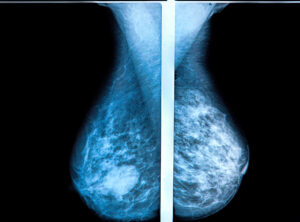

By now, most patients and physicians alike have heard of the “3 Dimensional (3D) mammogram.” This technology also goes by other names such as Digital Breast Tomosynthesis (DBT), 3D Tomosynthesis or just “Tomo.” Tomosynthesis is an advanced type of mammogram that provides a much clearer, more accurate view of the breast compared to standard 2 Dimensional digital mammography alone.
Tomosynthesis acquires images of the compressed breast at multiple angles during a short scan. The individual images are then reconstructed into a series of thin, high-resolution slices that can help eliminate challenges associated with overlapping tissue and structures in the breast that can give the illusion of an abnormality on standard 2D mammograms. Research has shown that tomosynthesis can reduce the number of times radiologists need to bring back patients for additional imaging for benign findings by 40%, while increasing cancer detection rates (particularly invasive cancers) up to 40%.
As 3D mammography involves more imaging, it is more radiation than a standard mammogram but still very low, safe and below the allowable dose for mammography. Special attention is paid to minimizing radiation exposure while capturing the highest quality images.
While more detailed imaging offered by 3D mammograms can benefit every woman, it has shown to be of the most benefit for patients with dense breast tissue. Roughly half of women across all ages have dense breasts. Legislation in Kentucky and many other states mandates that all patients receiving mammograms are informed if they have dense breasts in the result letter mailed to them after interpretation of the exam.
At UofL Health – Brown Cancer Center – Breast Care Center, we are currently operating with three tomosynthesis units, which means we can offer 3D mammography to all patients. Our mobile mammography van is also equipped with tomosynthesis, allowing us to bring this technology to women in the community who lack transportation, and to those who cannot travel to our breast center due to workday time constraints.
The American College of Radiology and the National Comprehensive Cancer Network (NCCN) still recommend that all average risk women begin annual screening mammography at age 40. For women with potential higher breast cancer risk, based on family or personal risk factors, these patients may need earlier or additional screening, and should speak with their clinical provider.
Only about 65% of the population is participating in screening mammography. Early breast cancer has no signs or symptoms. Screening mammography, especially 3D Tomosynthesis, can help detect small, early breast cancer that can lead to improved long term survival. I encourage all women to participate in screening mammography, whether it be conventional 2D digital mammography, or 3D mammography. At UofL Health, we are committed to the highest quality of care, and offer all patients access to the latest technology available in the fight against breast cancer.
3D Mammography are available at:
- UofL Health – Brown Cancer Center, call 502-562-4361, option 1
- UofL Health – Brown Cancer Center – Mobile Screening Unit, call 502-681-1405
- UofL Health – Mary & Elizabeth Hospital, call 502-681-1405
- UofL Health – Medical Center East, call 502-681-1405
- UofL Health – Medical Center Northeast – Breast Care Center, call 502-681-1405
- UofL Health – South Hospital, call 502-681-1405
- UofL Health – Shelbyville Hospital, call 502-681-1405
To schedule an appointment, call 502-681-1405 or visit our mammogram screenings page.









